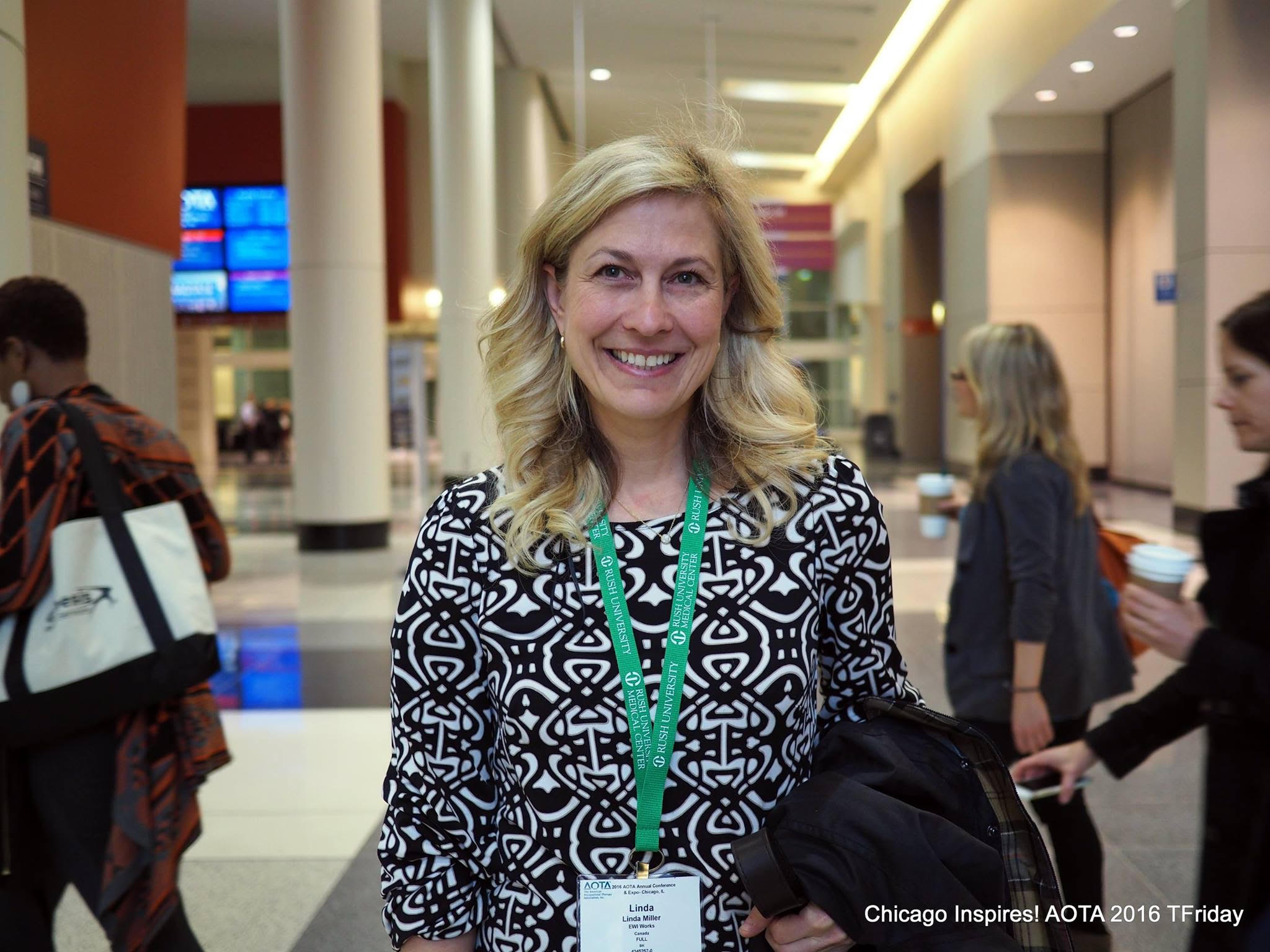
Linda Miller at AOTA Annual Conference, Photo by Michael Iwama
(Edmonton) When people think about the design and architecture of the colourful Edmonton Clinic Health Academy (ECHA) at the University of Alberta, they don't often realize that ergonomics and occupational therapy had a role in the development of the building.
Thanks to UAlberta alumna Linda Miller, ergonomics became a bigger focus in LEED certification (Leadership in Energy and Environmental Design) of buildings. The occupational therapist (OT) and alumni council representative for the Faculty of Rehabilitation Medicine was recently recognized for her contribution to LEED by Sargent College, Boston University where Miller received her doctorate of occupational therapy. She was presented the award at the American Occupational Therapy Association (AOTA) Annual Conference last month in Chicago.
"I have phenomenal peers and I thought, why not them!" said Miller, when she first found out she won the 2016 Occupational Therapy Alumni Award. Miller graduated from UAlberta's Faculty of Rehabilitation with a degree in occupational therapy in 1989. She is currently the President of EWI Works Inc., an occupational ergonomics company in Edmonton.
"Buildings have to be sustainable, not just in design, but also sustainable for the people who work there to be able to perform, to accommodate their tasks," said Miller.
Ergonomics became part of LEED certification when it was implemented as a pilot credit in 2012, but because it was an innovation credit still under the pilot library, people were not aware of it. Along with her fellow colleagues Lucy Hart from the Global Group and Mallory Lynch from the University of California Berkley, Miller set out to rewrite the credit so people would know how to apply for it, and to increase awareness of it.
They quickly realized that they had to speak the designer's language. They focused on mapping it out to make it more readable, developing a series of resources around how to write the application, creating infographics, and even a social marketing approach.
Their next step was to try to incorporate ergonomics into design. "Ergonomics is typically a reactive activity - someone has a problem and we try to fix it. I thought, can we get into the upfront phase to identify concerns so that they can be designed out?" said Miller.
Miller's long-term goal is to push the pilot credit into the indoor environmental quality category and to have it labelled for better visibility. In the next phase, the team aims to go out and talk about it: they recently participated in a conference in Orlando, have submitted to two others, and will be publishing papers.
"What I loved about the project was that I got to work with two other people, with diverse backgrounds and from across the country, and it was a chance to learn from each other's experiences and to collaboratively approach the U.S. Green Building Council," said Miller.
This collaborative, interdisciplinary approach is one that Miller takes into her work at EWI Works. "I've been so fortunate to build a truly interdisciplinary team. A PhD works for EWI Works, an industrial designer, an OT, a physical therapist, and certified kinesiologists. We approach a problem with lots of different views and break it apart," said Miller.
"It's fun to come to work! To me, this is what occupational therapy should be about," she continued.
Miller hopes to see this view spread. "When people work with an OT, they want to have one on their next project! We need OTs to become better advocates of their profession and research."
Miller found her niche in the field exploring how to adapt and better the workplace. "When I went through OT, I loved the study but didn't suit being a clinician in a hospital." But Miller describes occupational therapy as flexible. "It's diverse. We look at and assess what the problem is and come up with a solution, solve problems and prevent injuries and in the case of an injury, get them back to work full time.
"When I get complacent I think about a new way to apply OT. This field allows me to do that and that's the best part: the flexibility to keep re-engineering what I do."
She urges OT students and new grads not to limit themselves in what they think occupational therapy is today. "The profession and education have diverse backgrounds. Look for a niche that has not been filled. The opportunity is phenomenal!"
Miller is a clinical assistant professor in the U of A's Department of Occupational Therapy who believes a strong tie to your alma mater can be essential to future success. "As you come up with new ideas, don't forget your roots. There are lots of opportunities to work with the U of A."
"I love the U of A because the professors are superstars and so well known, even outside their fields. It's exciting that there are top people training the students."
"Congratulations to Linda. As an alumna of our faculty, she has always been an advocate for innovation in rehabilitation. She has shown the role occupational therapy can play in unconventional fields and I look forward to seeing her continue to contribute as a leader in rehabilitation," said Bob Haennel, interim dean, Faculty of Rehabilitation Medicine.
Join us for Family Fun Day - Free event for alumni and community
Join alumni and staff for our Family Fun Day event on June 4th from 1-4 pm on the Corbett Hall front lawn (8205 114 Street, University of Alberta). This free alumni and community event will allow people of all ages to learn about what occupational therapists, physical therapists, speech-language pathologists, and rehabilitation scientist do.
Featuring:- Face painting and balloon animals
- Rehabilitation medicine booths
- Free t-shirt for each child
- Games, snacks and draw prizes
- Photo booth with Guba, Patches and Disney Princesses
RSVP by June 1: http://bit.ly/FRMFamilyFun